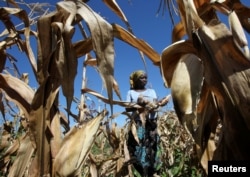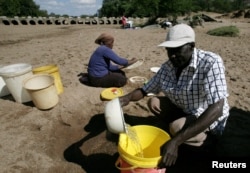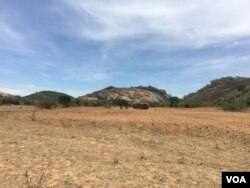In Zimbabwe, the U.N. Food and Agriculture Organization (FAO) has embarked on a $6-million program to rehabilitate irrigation schemes that President Robert Mugabe's government abandoned, leaving several communities exposed to drought.
A tractor at Jalukange Irrigation Scheme — near Zimbabwe's border with Botswana, about 700 kilometers south of Harare — is tilling the land for farmers to plant crops. A 57-hectare plot last had activity almost a decade ago before the irrigation scheme collapsed and left communities in this drought prone area with no source of food but to depend on handouts.
Teclar Muzamiri is one of the farmers who have moved back to her plot at Jalukange since the FAO provided funds to rehabilitate irrigation schemes in Zimbabwe. She left her plot in 2004. Now, she thinks this new project will change her fortunes.
High hopes
She says they are looking forward to improved farming to fight hunger. "We have no food because this area is dry. We cannot rely on rains because there isn’t much rainfall in this area, plus temperatures are very high. We want to plant maize because we have no food. Those who do not get handouts have to make brooms for sale."
Brooms are made of straw drawn from the Shashe River on the border with Botswana. For Teclar, it is difficult since she can't risk taking her 23-month-old twins Tinashe and Tadiwa to that river. So she wants water from the river to irrigate her plants.
Another farmer, Lameck Nkomo, is optimistic the FAO program will ease hunger in his family. He says the government is taking time, though, to work on the water canals at Jalukange Irrigation Scheme that destroyed years back by heavy rains.
"You see it's now open and the water now flows everywhere," he said, causing gullies. "It was the water going over the top instead of under as it ought to be. Another problem is the brand of maize seed we got this time is unfamiliar. The seed we got is not the one we would have preferred for this environment. We face water and power challenges and because of that we need early maturity varieties."
Grain reserve
Conrade Zawe, the head of irrigation development in Zimbabwe’s government, says he is aware of the issues farmers face in the country’s 80 smallholder irrigation schemes. He said the government is working on them. He is hopeful the rehabilitation program will ease Zimbabwe’s perennial problem of food shortages.
"The intention is to give inputs to farmers so that they can feed the [country’s] grain reserve and then make money themselves," said Zawe. "And then remain with food themselves. We are going to frantically ensure that happens. Over and above that we need to extend the area under irrigation from 206,000 hectares to at least 2.5 million. So, it's a long way to go."
It has been a long time since Zimbabwe — once the breadbasket of southern Africa — relied on its own for food. At the moment, it is one of the southern Africa countries to which FAO is giving funding in order to ease the region’s worst drought in 35 years.
The FAO says more than 40 million people need food assistance across southern Africa before the next harvest in March, with Madagascar, Malawi and Zimbabwe being some of the worst hit.










